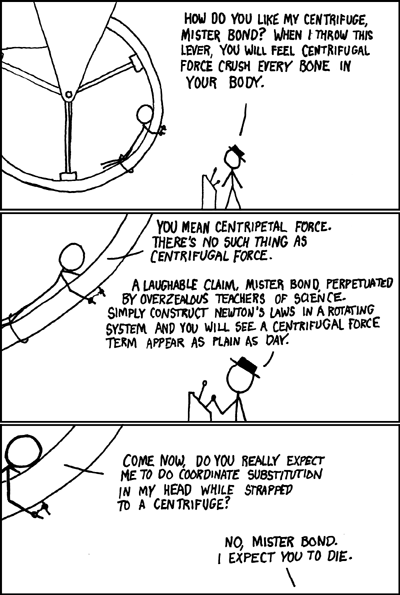Back when I was a kid I was taught about centrifugal force. I could swing a bucket of water up over my head and back down in a circle fast enough, and the water would stay in the bucket. I was told that centrifugal force held the water in the bucket.
Later, I think it was in college, I found out that explanation was completely wrong. There was no force acting on the water to push it away from me to keep it in the bucket. The bucket itself was pushing on the water, in the direction of my arm (towards the center of the circle), resulting in the water moving in a circle. Whoever told me this said it was called centripetal force and they explained there's no real force as centrifugal force. Centripetal force always acts towards the center of the circle an object is moving in.
Several times in my adult life I've gotten into conversations with people who refuse to accept this. They insist that centrifugal force is real and they defend it with some really silly reasoning. Some have suggested that it's a real force when you look at the forces in a moving frame of reference, but that only makes it seem like there's a force that isn't there. It's an apparent force used to make the math easier to deal with in that reference frame. Others just seem to *know* it's a force because they've believed it all their lives and refuse to consider otherwise.
This morning I had a debate online with someone and their best argument was an xkcd cartoon about the two forces.
Has anyone else had this conversation and attempted to change someone's mind about it?
Later, I think it was in college, I found out that explanation was completely wrong. There was no force acting on the water to push it away from me to keep it in the bucket. The bucket itself was pushing on the water, in the direction of my arm (towards the center of the circle), resulting in the water moving in a circle. Whoever told me this said it was called centripetal force and they explained there's no real force as centrifugal force. Centripetal force always acts towards the center of the circle an object is moving in.
Several times in my adult life I've gotten into conversations with people who refuse to accept this. They insist that centrifugal force is real and they defend it with some really silly reasoning. Some have suggested that it's a real force when you look at the forces in a moving frame of reference, but that only makes it seem like there's a force that isn't there. It's an apparent force used to make the math easier to deal with in that reference frame. Others just seem to *know* it's a force because they've believed it all their lives and refuse to consider otherwise.
This morning I had a debate online with someone and their best argument was an xkcd cartoon about the two forces.
Has anyone else had this conversation and attempted to change someone's mind about it?






